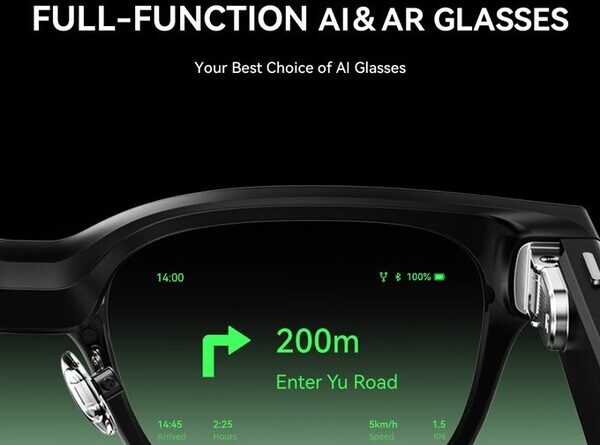Meta Introduces Groundbreaking Smart Glasses, Outshining Rokid’s Innovation
Meta has unveiled its latest smart glasses, equipped with single-eye, full-color display and an innovative, potentially path-breaking wrist controller called the Meta Neural Band. Another company at the forefront of smart glasses innovation is Rokid, which impresses with its latest model that utilizes a vivid green binocular waveguide display providing instant translation capabilities and AI assistant responses. The grand reveal of these devices at the Meta Connect keynote were filled with surprising updates, but the limelight was undoubtedly stolen by the Meta Ray-Ban Display, Meta’s cutting-edge smart glasses model.
These glasses not only integrate a pioneering waveguide display but introduce a potentially transformational control system. With this step, Meta marks a significant advancement in wearable technology. My recent experience testing the upcoming Rokid Glasses points to their design as being exceptionally user-friendly and sophisticated in their class. While having similarities, the Meta glasses components and design strategy diverges substantially.
The common element in both glasses is the use of waveguide displays, which employ engraved patterns within flat lenses for channeling images from a microprojector straight to the viewer’s eye. This technology results in a streamlined design for lightweight smart glasses, veering away from bulky prisms found in other models principally directed at video utilization. However, this streamlined design does require some compromise in the form of lower image quality, with waveguides offering less resolution and limited viewing fields compared to their prism-based counterparts. As a result, the projected visuals tend to be smaller and less detailed.
On comparing specific specifications, the Meta Ray-Ban Display offers a resolution of 600×600 pixels with a moderate 20-degree field of view, whereas Rokid Glasses offer a slightly lower 480×398 pixel resolution but a somewhat broader 23-degree field of view. A key distinction lies in the color display of the two glasses: while Meta offers a full-color display, Rokid restricts it to a monochromatic green. This gives Meta a distinct upper hand when dealing with content that requires a rich color display, including videos.
Where Rokid Glasses gain an advantage is their binocular projection using waveguide displays instead of the singular right-lens projection of the Meta Ray-Bans. This variation in display mechanism might be a concern for left-eye dominant users who may find their viewing experience affected. Both sets of glasses, however, are equally equipped with cameras of 12-megapixel power.
In terms of video capabilities, Rokid Glasses edge out their competition with the ability to record video clips at a substantial 2,400×1,800 resolution, compared to the 1,920×1,440 resolution offered by the Meta Ray-Ban Display. Both devices facilitate voice calling through in-built speakers and microphones, but if the need for video calls arises, Meta glasses are the go-to choice. This is because Meta Ray-Bans possess the capability for two-way video calling, a functionality missing from the Rokid Glasses.
The interface of Rokid Glasses is simple, encompassing a touch-sensitive panel for tapping and swiping, coupled with voice control. Meta, on the other hand, may possibly redefine the field with its innovative control strategy accompanying the Ray-Ban Display smart glasses. The Meta Neural Band is the company’s claim to fame, a wrist controller that is designed to read your muscle activity in order to control the glasses. Testing has shown this futuristic device’s prowess in tasks such as menu navigation and even text typing, hinting at its potential as a prototype for upcoming wearable input systems.
Smart glasses are incomplete without AI capabilities, and Meta makes no secret of its enthusiasm in this arena. With Meta AI integrated into its smart glasses, it promotes them as ‘AI glasses.’ The Ray-Ban Display supports a fully voice-controlled interface and can seamlessly display visuals such as photos and videos. On the other hand, Rokid provides users with two third-party AI agents to choose from.
These AI agents, standalone large language models (LLMs), do not have ties to expansive ecosystems like Meta. Users who do not wish to integrate their interactions with their social media data could see this as an advantage. Both these smart glasses have been designed to facilitate visual processing, allowing users to seek information about their physical environment and receive responses on their display. However, it is important to note that the utility, accuracy, and clarity of these responses can be largely variable.
Both devices additionally offer real-time translation, capable of detecting spoken words and displaying translations or captions in the user’s native language. This feature is invaluable, particularly for users who are hard of hearing. Realistic expectations need to be set regarding device usage durations. Both Meta and Rokid have indicated a battery life of up to six hours for their devices.
When it comes to pricing, Meta has set a $799 price point for the Ray-Ban Meta Display, while the Rokid Glasses will retail for $599 post completion of their crowdfunding campaign. Having spent some time with the Rokid Glasses, they seem a well-refined and polished step forward compared to their earlier waveguide smart glasses counterparts. Their intuitive and reliable design makes them great for quick tasks like capturing photographs or translating languages without any major adjustments to our existing usage patterns.
On the contrary, the Meta Ray-Ban Display is aiming for significantly greater heights. Its audacious innovation is the Meta Neural Band, an entirely new control system with the potential of being groundbreaking or rather challenging. With a more conventional interface like Rokid’s touch pad, the Meta device with its high-resolution, full-color display could have been a standout on its own.
However, for individuals wary of the constant surveillance of the Meta AI, this feature could be a deterrent. From a technological perspective, the Meta Ray-Ban Display may seem like the more advanced option, despite the unpredictability of the wristband controller.

